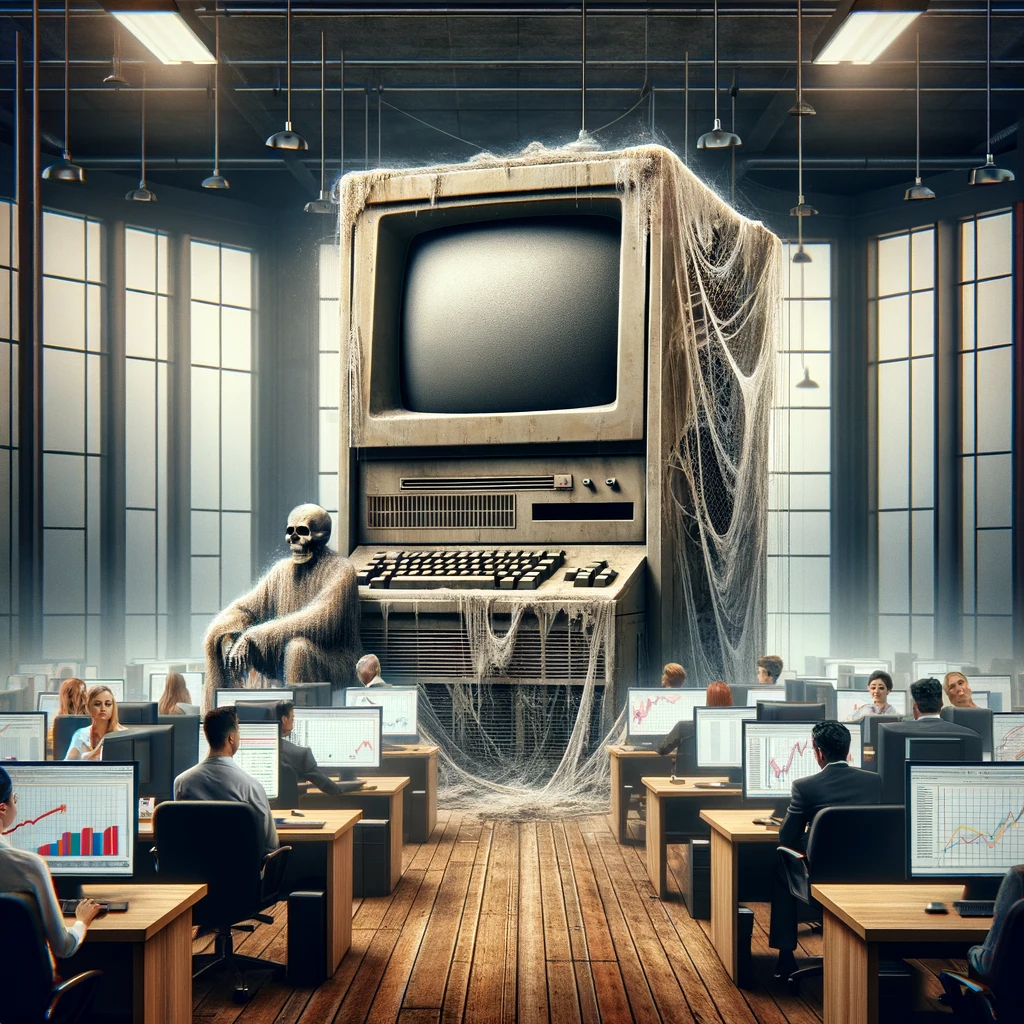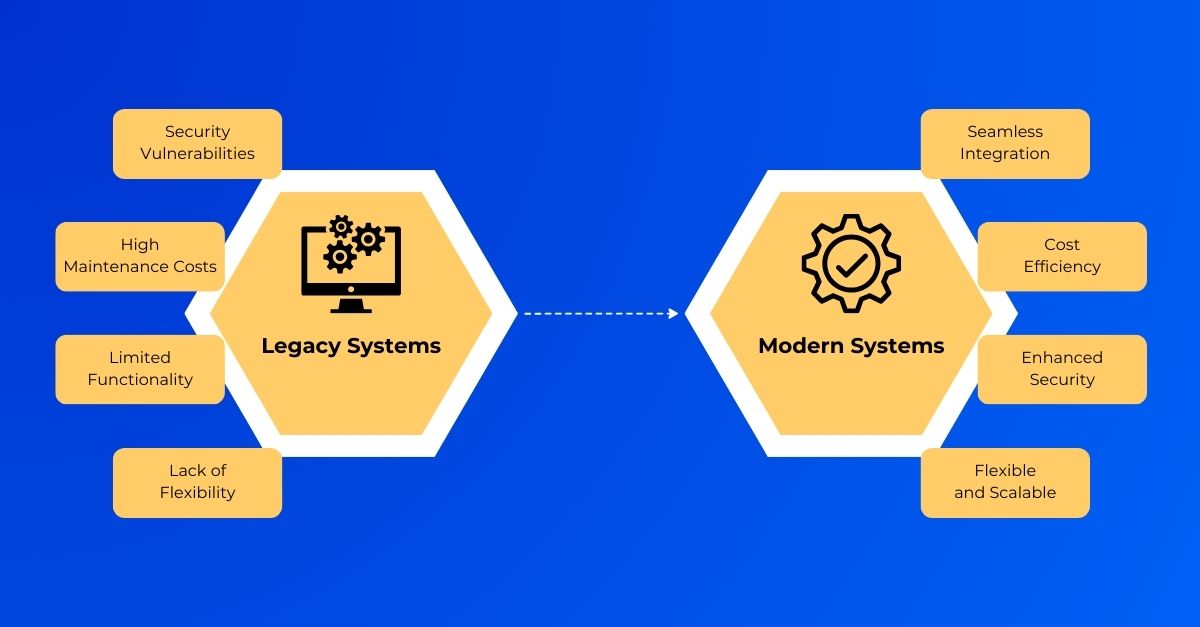Legacy systems are the proverbial ball and chain of tech, holding businesses back from the full potential of the digital age. When it is so important to constantly evolve and adapt in order to stay ahead in the game, it is quite alarming that old, outdated systems are still playing a key role in the operations of some companies. If you’ve ever found yourself wondering what a legacy system is, why they are still used, how you can replace them, and why you definitely should, you’re in the right place.
What Are Legacy Systems?
A legacy system refers to outdated software or hardware that remains in use, usually because it plays an integral role in critical business operations. It’s quite tricky to find a consistent definition for legacy systems, but if you’re having to ask whether you are using a legacy system, then you probably are. A few key characteristics of legacy systems are:
- Legacy systems are built on outdated or obsolete technologies, often using programming languages, frameworks, or hardware that have long been replaced by more modern and efficient alternatives.
- Legacy systems tend to lack integration capabilities.
- Legacy systems have limited scalability, and are typically quite rigid.
- Maintaining legacy systems can be resource-intensive.
- Outdated software is more susceptible to security risks.
Examples of Legacy Systems
- Outdated database systems such as Microsoft Access, dBASE, FoxPro.
- Mainframe computers like IBM System/360 or AS/400.
- Custom-built software can also be deemed a legacy system if it is not sufficiently maintained and updated.
- Older Enterprise Resource Planning (ERP) systems including SAP R/3, and Oracle E-Business Suite (11i or earlier).
- Obsolete operating systems like Windows XP and Windows Server 2003.
- Legacy programming languages such as COBOL and Fortran. (note, not the ones that we use at Moonive)
There are, of course, many other examples of legacy systems, like fax machines and the BlackBerry phone you threw in your drawer and forgot about, but you get the idea.

Why Are Legacy Systems Still Used?
If companies are still using legacy systems, then they must be useful, right? Sure, in the same way a broken clock is right twice a day. We joke, but despite the outstanding potential of modern systems and newer technologies, legacy systems are unfortunately still prevalent in a lot of businesses. In fact, over 90% of the UK’s financial services firms still rely on legacy technology. A few reasons why legacy systems are still around include:
- Fear of Disruption: Digital transformation can be a very disruptive process. It’s complex, taking time and careful planning. Some companies struggle to see past the initial turbulence and so the benefits of modernisation are blocked from view.
- Specialisation: Some businesses have highly customised legacy systems, fulfilling a very specific function. A lack of off-the-shelf solutions offering the exact same level of customisation can act as a deterrent for updating systems. Why they can’t invest in a new bespoke system, however, we’re not too sure.
- Investment Protection: Companies who invested significantly in the development and/or implementation of systems, before they were legacy, can be hesitant to consider a significant upgrade, in an attempt to maximise the return from their initial investment.
- Perceived Stability: The old “if it’s not broke, don’t fix it” scenario. Some businesses are simply used to their legacy systems, and introducing new technologies can be daunting due to the risk of unforeseen bugs or errors, especially when current systems appear to be plodding along just fine.
- Resource Constraints: A lack of cash, coupled with a shortage of skilled professionals familiar with legacy technologies, can be another factor blocking the process of migrating away from outdated systems, and some companies will often opt for short-term cost savings over long-term benefits.
What’s The Problem With Legacy Systems?
Now that we’ve laid out what legacy systems are, let’s take a look at some of the challenges that they pose, and how they can hinder the efficiency, security, and overall competitiveness of a business. Some common problems associated with legacy systems are:
- Security Vulnerabilities: A lot of outdated systems are no longer supported by the manufacturer, meaning they are no longer providing updates or patching vulnerabilities. It’s estimated that unpatched vulnerabilities are linked to 60 percent of data breaches , making legacy systems a common target for cybercriminals.
- High Maintenance Costs: Maintaining and supporting outdated technologies can be costly. It’s difficult to find people skilled in old systems, which makes them more expensive to source. In 2021, the UK Government was spending 50% of it’s IT budget on servicing legacy tech.
- Inefficiency and Limited Functionality: Legacy systems lack the efficiency and functionality of modern solutions, resulting in slow processes and reduced productivity. 48% of UK employees waste at least three hours or more per day due to inefficient systems.
- Regulatory Compliance Risks: Legacy systems may struggle to comply with new regulatory requirements as they evolve. This can expose a business to legal and regulatory risks, especially in industries with stringent compliance standards.
- Difficulty in Customisation: Legacy systems are often difficult to customise to meet evolving business needs, and the lack of flexibility can restrict innovation and hinder a company’s ability to adapt to changing market dynamics.

What’s The Solution?
So, how can you steer clear of these pitfalls? That’s where bespoke, web-based solutions come in – not just a modern buzzword, but your strategic lifeline. If what we have discussed so far is not enough to sway you to looking into alternatives to legacy systems, here’s a few reasons why converting to the cloud could be the perfect option:
- Integration Capabilities: Modern web-based solutions are designed with integration in mind. They can easily integrate with other software, applications, and third-party services, creating a connected and streamlined architecture that legacy systems may struggle to achieve.
- Cost Efficiency: While the initial investment in bespoke solutions may seem higher, the cost efficiency is significant in the long run. Rather than spending most of your IT budget on maintaining an outdated system, you could reinvest this cash elsewhere in your business, and enjoy a healthy return on the investment in a new system through increased productivity and reduced maintenance costs.
- Enhanced Security Measures: Modern web-based solutions incorporate advanced security features to protect against evolving cyber threats. Coupled with the ease of implementing updates and patching vulnerabilities, businesses can confidently safeguard their data and ensure compliance with industry regulations.
- User-Friendly Interfaces: Bespoke web solutions often provide intuitive and user-friendly interfaces. This improves the overall user experience, leading to increased employee satisfaction, faster onboarding for new users, and can help retain those valuable employees who may get sick of using inefficient legacy systems.
- Scalability and Flexibility: Where legacy systems are often rigid and difficult to scale, web-based solutions tend to be the complete opposite. Whether you need to expand operations, integrate new features, or accommodate a larger user base, you can do so with much less hassle than if you were running an old, obsolete system.
To Wrap Things Up
Legacy systems remain an ongoing challenge for businesses – slowing things down, burning cash, and leaving you vulnerable to cyber attacks. The idea of replacing these seasoned systems may be daunting, like trading in your trusty old car for a flash, new model. However, it’s not just a switch; it’s a strategic decision, a calculated investment guaranteed to provide long-term benefits for you and your business.
Embracing modern solutions isn’t merely about chasing the latest trend. It’s setting your business on the right path for enhanced efficiency and future-proofed business landscape. Sure, it may seem like a leap of faith, but it’s a leap toward streamlined operations, cost-effectiveness, and digital resilience.
So, as you stand at the crossroads of legacy systems and a web-based future, consider the evidence and think about the possibilities. Explore how Moonfive can guide you toward a bespoke solution tailored to your needs, ensuring a future where efficiency and innovation take centre stage, and get in touch today.

